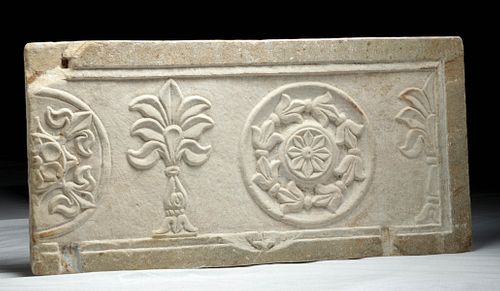Large Romano-Byzantine Marble Panel - Florals
Lot 24
About Seller
Artemis Gallery
686 S Taylor Ave, Ste 106
Louisville, CO 80027
United States
Selling antiquities, ancient and ethnographic art online since 1993, Artemis Gallery specializes in Classical Antiquities (Egyptian, Greek, Roman, Near Eastern), Asian, Pre-Columbian, African / Tribal / Oceanographic art. Our extensive inventory includes pottery, stone, metal, wood, glass and textil...Read more
Categories
Estimate:
$6,000 - $8,000
Absentee vs Live bid
Two ways to bid:
- Leave a max absentee bid and the platform will bid on your behalf up to your maximum bid during the live auction.
- Bid live during the auction and your bids will be submitted real-time to the auctioneer.
Bid Increments
| Price | Bid Increment |
|---|---|
| $0 | $25 |
| $300 | $50 |
| $1,000 | $100 |
| $2,000 | $250 |
| $5,000 | $500 |
| $10,000 | $1,000 |
| $20,000 | $2,500 |
| $50,000 | $5,000 |
| $100,000 | $10,000 |
| $200,000 | $20,000 |
About Auction
By Artemis Gallery
Oct 22, 2020
Set Reminder
2020-10-22 10:00:00
2020-10-22 10:00:00
America/New_York
Bidsquare
Bidsquare : Ancient & Ethnographic Art Through The Ages
https://www.bidsquare.com/auctions/artemis-gallery/ancient-ethnographic-art-through-the-ages-5850
Ancient art from Egypt, Greece, Italy and the Near East, as well as Asian, Fossils, Pre-Columbian, Native American, African / Tribal / Oceanic, Fine art, and much more! All categories, all price ranges... all legally acquired and guaranteed to be as described or your money back. Artemis Gallery info@artemisgallery.com
Ancient art from Egypt, Greece, Italy and the Near East, as well as Asian, Fossils, Pre-Columbian, Native American, African / Tribal / Oceanic, Fine art, and much more! All categories, all price ranges... all legally acquired and guaranteed to be as described or your money back. Artemis Gallery info@artemisgallery.com
- Lot Description
Late Roman to Early Byzantine, ca. 5th to 7th century CE. A large section from a marble relief sarcophagus panel with beautiful floral and abstract geometric motifs. Featured is a relief roundel containing an eight-petaled flower surrounded by interlocking acanthus leaves. An identical roundel is partially repeated on one end of the panel. Between them - and repeated again in half-form on the other end of the panel - is a large acanthus leaf/flame motif. A thick carved border demarcates the exterior edge of the panel on three sides. Tomb decoration during this time period relied on abstract representations; in earlier pagan times mythological figures and scenes had been important parts of memorials. Here, symbolism was more important; the use of acanthus leaves, for example, came from the architect Callimachus, who was inspired by seeing the plant growing through the woven sides of a votive basket left at the grave of a young girl. Size: 1.4" L x 36.5" W x 18" H (3.6 cm x 92.7 cm x 45.7 cm)
Prior to the 2nd century, Romans cremated their dead; around that time, inspired by the Greek and Etruscan practice of using sarcophagi, they began to place the deceased in sarcophagi. This trend spread rapidly throughout the Roman Empire and continued into the Byzantine period. In the western part of the Empire, sarcophagi were placed inside a mausoleum against a wall or in a niche, so the only decorated panels were on the front and the short sides. This panel probably came from the grave of an elite citizen.
Provenance: private J.H. collection, Beaverton, Oregon, USA, acquired in October 2018; ex-private Montrose, California, USA collection; ex-private London, UK collection, acquired in the late 1960s
All items legal to buy/sell under U.S. Statute covering cultural patrimony Code 2600, CHAPTER 14, and are guaranteed to be as described or your money back.
A Certificate of Authenticity will accompany all winning bids.
We ship worldwide and handle all shipping in-house for your convenience.
#149587Loss to one corner and along the lower rim. Small area of repair on one of the floral bosses. Two grooves have been excavated from the lower edge. Small chips, nicks, and scratches on surface, but overall it is beautifully preserved with the motifs in very nice condition. Light deposits.Condition
- Shipping Info
-
All shipping is handled in-house for your convenience. Your invoice from Artemis Gallery will include shipping calculation instructions. If in doubt, please inquire BEFORE bidding for estimated shipping costs for individual items.
-
- Buyer's Premium



 EUR
EUR CAD
CAD AUD
AUD GBP
GBP MXN
MXN HKD
HKD CNY
CNY MYR
MYR SEK
SEK SGD
SGD CHF
CHF THB
THB














